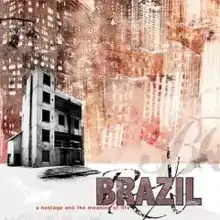A Hostage and the Meaning of Life
A Hostage and the Meaning of Life is an album by the rock band Brazil that deals with themes of technology, dehumanization, and frustration. Musically, it borrows from complex genres such as progressive rock and classical music, as well as the abrasive aesthetic of punk, and the ethereal guitar sounds of shoegazer pop. It was received warmly by many critics as a masterful debut album from a previously unknown band. The album's single “Escape” received a small amount of college radio play, and the video appeared in rotation in several regional and national music video programs.
| A Hostage and the Meaning of Life | ||||
|---|---|---|---|---|
 | ||||
| Studio album by | ||||
| Released | September 26, 2004 | |||
| Recorded | Grandma's Warehouse, Los Angeles, CA | |||
| Genre | Progressive rock, post-hardcore | |||
| Label | Fearless | |||
| Producer | Alex Newport | |||
| Brazil chronology | ||||
| ||||
The album takes its name from Asimov's Caliban trilogy, although has nothing to do with the story itself.
Concept
There has been much speculation as to whether or not Hostage was a concept album. Singer and lyricist Jonathon Newby has been very vague in determining the validity of the claim, only to say “unless a band is putting out a Greatest Hits record, then by definition, all albums are concepts” in many interviews. One theory asserts the story as a Reverse Pinocchio fable about a human boy trying to become a robot. The key characters in this scenario are Pale, the boy, and Stark, a female android Pale has fallen in love with. In this scenario, the exclusive worlds of humans and robots forbid the romantic involvements of one with the other. Only by becoming a robot himself can Pale rightfully achieve acceptance into Stark's world. Most of the songs on the record deal with themes of longing and dehumanization.
Recording
Hostage was recorded near downtown Los Angeles at Grandma's Warehouse Studio by Alex Newport, whose band discography includes Fudge Tunnel, Nailbomb, and Theory of Ruin, and whose producer discography includes The Locust, Kylesa, and The Plot to Blow Up the Eiffel Tower. The session included one day of pre-production in a rehearsal studio, nine days of tracking, and four days of mixing. Two of the tracking days were completed in Newport's Echo Park apartment.
The Single
"Escape" was chosen as the album's single and was promoted to college airplay. The album's only video was shot for Escape by Michael Grodner in Los Angeles and comprised a two-day shoot with volunteer actors and crew. The interior shots of the band playing were filmed inside the Ronald Reagan Building in downtown Los Angeles. The rooftop scene was filmed on top of an artist studio in the warehouse district outside of the downtown area of the city.
Reception
| Review scores | |
|---|---|
| Source | Rating |
| Allmusic | |
| Alternative Press | |
Hostage was received with much praise from the underground press upon its release, including a 5-star review in Alternative Press, as well as near perfect scores in many other print and online publications. Popularly, the band have gained a relatively small but devoted fan base worldwide, but have not yet achieved a high level of mainstream acceptance.
Track listing
- "A Hostage" – 2:56
- "The Novemberist" – 4:47
- "Io" – 3:34
- "Escape" – 3:14
- "We" – 3:03
- "The Iconoclast" – 5:19
- "Zentropa" – 3:04
- "Fall Into" – 4:15
- "Metropol" – 6:41
- "Aventine" – 3:45
- "Form and Function" – 2:12
- "Fatale and Futique" – 5:14
Credits
Jonathon Newby – Vocals, MOOG, vocoder
Nic Newby – keyboards
Aaron Smith – electric guitar
Eric Johnson – electric guitar
James Sefchek – drums
Benjamin Hunt – bass
With
Alex Newport – producer, engineer, mastering
Matt Miller and J.R. Cary– pre-production
Album Photography – Lisa K. Fett
Sleeve Art – Colin May
Tim Loo, the cellist on Iconoclast and Fatale and Futique, is a touring musician for pop artist Ben Harper.